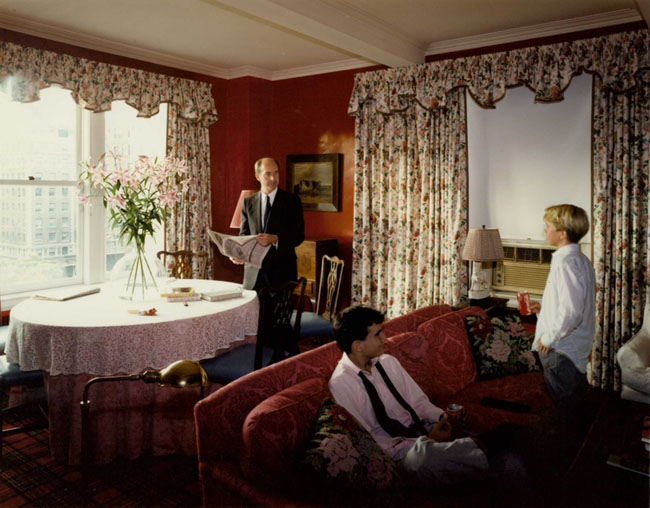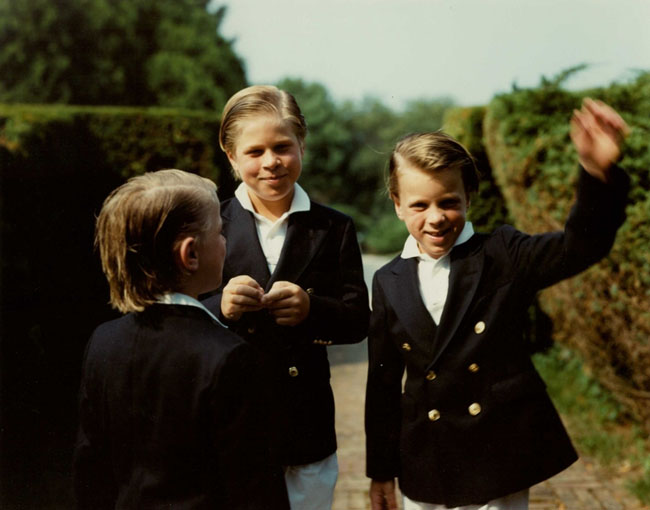Tina Barney has been lurking around the edge of my consciousness for a couple of years. I was aware of her work in the vaguest sort of way; I knew she was a woman from the privileged classes who shot large format portraits of other people from the privileged classes. As a product of the working class, I simply couldn’t rouse enough interest to go to the bother of learning about her. Whenever I came across her name or saw an example of her work, I was reminded of Oscar Wilde’s description of fox-hunting: the unspeakable in pursuit of the inedible.
That changed last week when I saw a documentary film (Social Studies) about Barney and her work. By the end of the film I’d developed a sort of grudging respect for her work, for her approach to the work, and for the woman herself. I found myself liking her and her unapologetic treatment of her subject matter.
She was born in New York in 1945. Hers was a privileged life: travel, good schools, skiing, servants, shopping, coming out parties; all the trappings of wealth. Not merely accumulated wealth, but established wealth—generational wealth. Tina Barney was born into old money. That fact matters; it matters in society, it matters in Barney’s photography.

She married, had children, and in the early 1970s moved west with her husband. That move, it seems, changed everything. There was, Barney has said, only so much shopping and skiing she could do. She began to feel bored with the life she was living and felt the need to do something. She also began to feel a need to be on her own. She got a divorce and took up photography.
That sounds dismissive, doesn’t it. She got a divorce and took up photography. As if these were simply things that one does when one has money and time. Like trading in last year’s car for this year’s model. In fact, Barney’s maternal grandfather had introduced her to photography when she was fairly young. She’d begun collecting photographs when she was 26 years old. That was in 1971, during the very earliest stages of what has developed into the photography market. The progression from studying and collecting photographs to picking up a 35mm camera and shooting photographs of her own seems perfectly natural and logical.
She began, not surprisingly, by photographing her family and friends.
“Nostalgia is the basis of how I began. The fact that I moved out west, that I missed home so badly, that’s when I noticed how precious and important my home was back there.”
Barney soon abandoned her 35mm camera for a large format 8×10 unit, which allowed her to produce massive prints—four by five feet. She was one of the first photographers to produce color prints of that size. The size of the prints permits the viewer to see the environmental details so critical to Barney’s work. (Obviously, the images in this salon cannot do justice to the prints.)
“I want to make approaching the image possible. I want every object as clear and precise as possible so that the viewer can really examine them and feel as if they are entering the room.”

Despite her use of large format equipment, Barney keeps her camera movement as fluid as possible. She prefers to photograph her subjects in their own homes or offices, where they’re surrounded by their own things. Rather than establish a location for the subject to sit, she seems to select a room or an area and allows her subjects move around moderately freely within that space. Because she keeps her camera as mobile as possible, she manages to catch spontaneous moments. She is less concerned about keeping her background lines parallel to the horizon than she is with catching the physicality and expression of her subjects.
Very early on, Barney realized the environment in which she photographed her subjects was as revealing as the expressions on their faces—and, in some cases, more revealing. Many critics, especially early in her career, have complained about the emotional reserve of her subjects. Some of that reserve may be a result of the camera and photographer, of course; an 8×10 camera on a sturdy tripod makes a serious intrusion into a family’s personal space. But part of her subject’s emotional reserve, as Barney notes, is learned behavior.
“When people say that there is a distance, a stiffness in my photographs, that the people look like they do not connect, my answer is, that this is the best that we can do. This inability to show physical affection is in our heritage.”
That emotional reserve creates a sort of understated tension in Barney’s work. Even though her subjects trust her enough to invite her into their homes, to interrupt their lives by allowing her—and often an assistant—to clutter up their space with a massive camera and tripod, there remains a sort of wariness. Old money does not call attention to itself. “There is an overall feeling of old money that you have to guard it,” Barney has said, “and I’m part of that.”
That’s a very telling comment. She is part of that. Cultural familiarity—knowing your subject’s milieu, being comfortable in it, being able to make your subjects comfortable—is an aspect of informal location portraiture that’s generally celebrated (and for all their apparently formality, these are informal portraits). We appreciate that approach in the work of Anders Petersen, who was able to insert himself into the night life of Hamburg’s Reeperbahn district, or Juliana Beasley, who turned her stripper’s background into a platform for a photographic series. They photographed the people they associated with, and gave their viewers a glimpse into a world they might not have witnessed otherwise. We tend to dismiss the importance of that sort of intimate knowledge in Barney’s work because she comes from a privileged background and photographs her own people. And yet, like Petersen and Beasley, Barney is revealing a segment of society that ordinary people never get to see.

This is perhaps the greatest hurdle Barney has to clear. She has the burden of wealth and privilege. As burdens go, it’s not a bad one to have—but it is, nevertheless, a burden. It’s simply easier for critics and viewers to dismiss her work based primarily on her social status. I certainly did. Poor and working class folks, we know, have to struggle to live as artists. Rich folks have fewer obstacles to overcome; they have access to better equipment and better instructors, they have entrée to the social networks necessary to have their work shown in galleries, they never have to worry about paying their bills or earning a living.
We are generally willing to overlook all that if an artist from the upper classes works outside the class structure. We don’t mind that Robert Frank came from wealth, because he celebrated outcasts and ordinary people. We ignore the fact that Lee Miller came from wealth, because she became a war photographer and lived with the troops. We are inclined to be less forgiving when a member of the upper classes chooses the upper classes as the subjects of her art.
Although she photographs the upper classes almost exclusively (there have been very few exceptions) Barney makes an argument that the greater body of her work is not about class. It’s about families and the way families interact, and it’s about what she believes is the demise of a certain way of life. “How people treat each other is more interesting to me than what class the come from,” Barney says.

While I believe Barney when she says that, I think she’d acknowledge that it’s impossible to separate the people she photographs from their class. What they own and how long their family has owned it is an integral part of who they are. The relationship between these people and their possessions is one of the features that distinguish old money from the nouveau riche. “You can tell who is the real McCoy,” Barney says in the documentary film, “and who isn’t.” It’s clear she’s not saying that to denigrate those who aren’t “the real McCoy,” she’s simply stating a cultural fact.
That reality becomes apparent in the film when she began her series of images of European royalty. Barney may come from old money, but there is old money and really old money. Speaking of her preference for photographing the wealthy, she says “it’s a matter of familiarity—not that I’m familiar with living in a chateau, but more familiar than I’d be in Harlem.”
And there it is. Barney photographs the people she knows, the people with whom she is comfortable, the people who are comfortable with her. She has refused to accept assignments from magazines asking her to photograph poor people, not because she doesn’t want to associate with the poor but because “it would be hypocritical and shallow. How could I know what they were all about?” Her refusal is, in a very real way, an act of good manners. For her to visit the homes of the poor and photograph them would be an act of voyeurism.
I’ve come to appreciate Tina Barney’s work, and to appreciate her approach to it. I’m not sure I’d like the people she photographs (which shows just as much class bias as would a rich person saying he might not like to spend time with the working class), but I’ve grown intrigued by their portraits. It’s also made me more aware of my own prejudices, which is rather uncomfortable. But then a lot of good art sometimes makes the viewer uncomfortable. Sometimes that’s a good thing.
